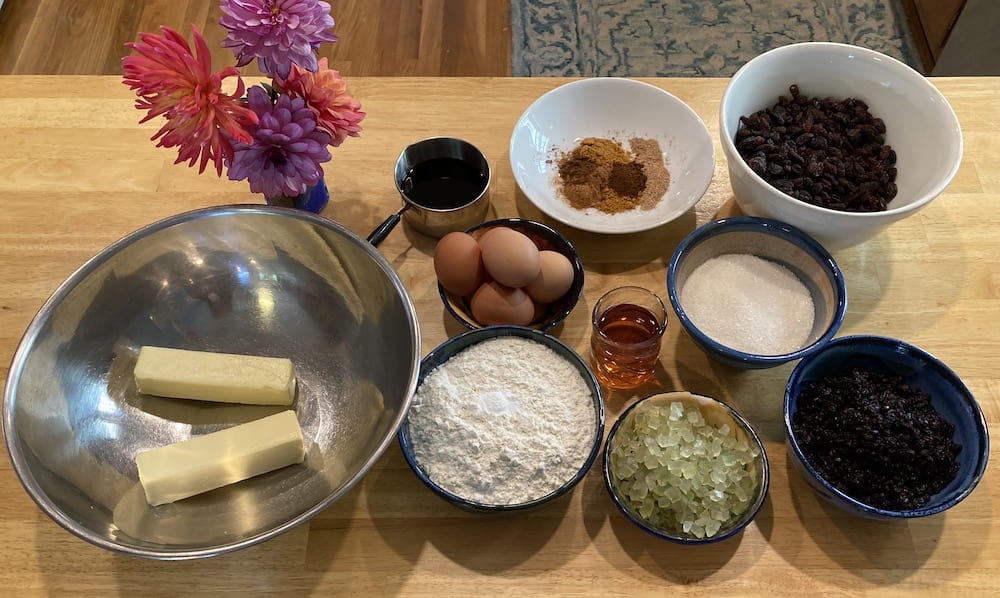By Emily Walhout, Reference Assistant, Public Services and
Christine Jacobson, Assistant Curator of Modern Books and Manuscripts
Around this time of year, Team Cake’s thoughts turn toward fruitcake. Emily Dickinson’s “black cake” to be precise—a 20-pound cake darkened by molasses and boasting 8 pounds of combined raisins, currants, and citron. The original manuscript of the recipe for this hefty cake, written in Miss Dickinson’s own hand, is housed in Houghton Library’s Emily Dickinson Collection.
Now, fruitcake is not a word that generally elicits delight or happy memories. A more common reaction might be skepticism or even a gasp of alarm. But Emily Dickinson’s black cake is not your average fruitcake. Along with the molasses and brandy, an assortment of aromatic spices goes a long way in giving this cake its memorable flavor.
For the past five years, Team Cake—a troupe of brave and curious bakers at Houghton—has recreated this cake, rigorously adhering to the poet’s recipe, and served it up to colleagues and friends at celebration of the poet’s birthday on December 10. Fruitcakes are traditionally steeped in brandy and stored away for months to mature and ripen, so September is the time to get a cake underway if it’s to be shared in December.

In years past, we’d physically gather to honor the poet, recite a few poems, and sample the long-awaited cake. The COVID-19 pandemic has thrown a wrench in the works of our sixth annual celebration, but Team Cake will not be deterred! On the contrary—we are excited this year to invite anyone who’s interested to join the Team and bake along with us. Our collective efforts will culminate with a virtual birthday party on December 10.
We encourage intrepid bakers to give it a go at home and join us on the 10th, a piece of your black cake in hand, to hear some of Emily’s poems and share your fruitcake stories. Understandably, you may not want to be saddled with the full 20 pounds of black cake, so we suggest making a quarter recipe, provided below. Emily’s recipe is curiously silent on a few crucial details—we think you may appreciate that we include the all-important oven temperature and baking time gained from years of experience.
Details and registration for Emily’s virtual birthday party will be available later in November, so keep an eye on the blog or on Houghton Library’s social media. We invite you to post pictures of your bakes using the hashtag #BakingWithEmilyD.
Happy Baking!

Emily Dickinson’s Black Cake (quarter recipe)
8 oz. (227 g.) flour
8 oz. (227 g.) sugar
8 oz. (227 g.) butter
5 eggs
20 oz. (570 g.) raisins
6 oz. (170 g.) currants
6 oz. (170 g.) citron
2 oz. (60 ml.) brandy (see Note below)
2 oz. (60 ml.) molasses
half a nutmeg, grated (roughly 1¼ teaspoon grated nutmeg)
1¼ teaspoon cloves
1¼ teaspoon mace
1¼ teaspoon cinnamon
½ teaspoon baking soda
Emily’s recipe reads: “Beat butter and sugar together. Add eggs without beating and beat the mixture again. Bake 2½ or three hours in cake pans, or 5 to 6 hours in milk pan, if full.”
Team Cake suggests:
- In a small bowl whisk together the flour, spices, and soda.
- In a large bowl, cream the butter and sugar.
- Mix in unbeaten eggs until blended, then mix in the brandy and the molasses.
- Add dry ingredients and mix well.
- Add raisins, currants and citron and mix until fruit is well-distributed.
- Pour batter into a greased 9 x 13 inch (23 x 33 cm) baking pan lined with parchment paper on the bottom. Bake at 250 ºF (120 ºC) for three hours. When cool, wrap cake in a cheesecloth soaked in brandy. Store in an airtight container in the fridge.
- Every once in a while over the coming weeks and months, baste with more brandy. The cake can be eaten any time after it emerges from the oven, but the longer you store it, the tastier it will be!
Note: Team Cake has always enjoyed beating, mixing, blending, and grating by hand to get that 19th-century experience, but you could use an electric stand mixer instead. Unfortunately, we don’t have any how-to advice on mixing with the electrics, but we’re pretty sure you can’t wreck this cake! We regret to say that we haven’t experimented with brandy substitutions, but if you have a suggestion, we welcome it in the Comments. (Brandy does act as a preservative, but we err on the side of caution with our decidedly un-19th-century refrigerator!)
Check out the video of our first bake back in 2015 for more guidance—but please note there’s a typo at 2:31. Instead of starting with the eggs and sugar, you should begin with beating room temperature butter and sugar together.

